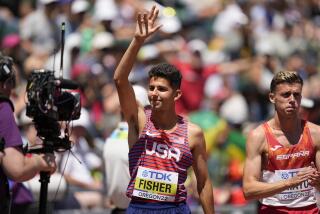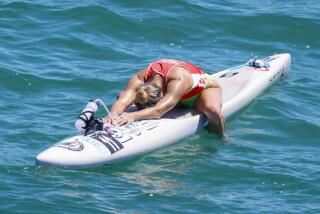In a Rush : Team Aims to Shatter Transcontinental Record in High-Tech Bike
- Share via
Four buddies will set out today from Orange County on a quick cross-country jaunt--with plans to arrive in New York in, oh, say, a bit more than four days.
On a bicycle.
The foursome will leave the Orange County Fairgrounds at noon in hopes of beating three other teams participating in the inaugural event for ultra-sophisticated, two-wheeled vehicles in the Race Across America.
The four Olympic-caliber cyclists will ride around the clock by taking turns behind the handlebars while their counterparts rest in a support van. They hope not only to win the race but also to set the world record for the fastest crossing of the United States on a bicycle.
Obviously, the contraption they will ride is no ordinary 12-speed.
Dubbed Gold Rush America, the 45-pound cycle looks every bit as sophisticated as a Stealth bomber. Wrapped in an aerodynamic sheath of bright-gold Kevlar, it is capable of speeds over 55 m.p.h. and features a two-way cockpit radio, a zip-on windshield and 56 gears.
The bike is designed so the riders sit upright with their legs cranking a set of pedals mounted toward the front of the sleek craft on a chromium-molybdenum-steel alloy frame.
Outfitted with turn signals, taillights and a halogen headlight, the cycle is a street-legal version of Gold Rush, a high-speed bicycle that team member Fred Markham rode in 1986 to a land speed record of more than 65 m.p.h. The record-setting bike now sits proudly in retirement at the Smithsonian Institution.
“This new bike won’t have the top speed of the Gold Rush, but it’s built for a different purpose,” said Markham, a former U.S. Olympian known as “Fast Freddie” even before he set the 1986 record. “It’s heavier, a little less streamlined, but a lot more practical and tough.”
The $20,000 bike was designed and built by Gardner Martin, a self-schooled engineer who manufactures unique bicycles in a small shop in Freedom, a tiny
berg on Monterey Bay in Northern California. Since the mid-’70s, Martin has been pioneering the production of so-called “supine recumbent” bicycles, which feature the stretched-out setup incorporated in creations like Gold Rush America.
Martin doesn’t mince words when describing why he and the cyclists took on the challenge of crossing a continent under pedal power.
“To go where no man has gone before! To risk the impossible!” Martin roared only half in jest as the group gathered at a Seal Beach bike shop Friday to prepare for the journey.
“There’s a certain kind of person who enjoys being on the cutting edge. For me, this is the cutting edge of engineering. For the riders, it’s the cutting edge of performance and danger.”
Riding the high-tech cycle is a bit different than a spin down to the corner market on your Schwinn. With its wind-slicing profile and light curb-weight, the machine can buck from side to side in crosswinds or head downhill at speeds nearing 70 m.p.h.
“It’s a lot more scary than an E-ticket ride at Disneyland,” said team rider Greg Miller, the bike shop owner and a former Olympic team member.
No one knows better than Fast Freddie. A few years back, he was pedaling the bike’s predecessor through a high-speed time trial when a gust of wind swooped down and sent the cycle sliding down the highway at 60 m.p.h. When Markham came to rest 300 feet away, he was shaken, but escaped without serious injury.
“I’ve fallen over at a stoplight and been hurt worse,” he said.
Like his colleagues, Markham sees the event as a hefty test of his endurance skills and a psychological challenge. Designer Martin sees a more practical outgrowth of it all.
He hopes such technological displays will help push society to accept a replacement for automobiles, envisioning a day when streamlined, solar-powered cars--the “natural offshoot,” he contends, of Gold Rush America--will flood the streets of America.
First, however, a race must be won.
Long a test of human endurance for riders of traditional bicycles, Race Across America for the first time features a category this year for “human-powered vehicles” like Gold Rush America.
Among the competitors is Lightning, a 31-pound cycle piloted by a team led by Pete Penseyres of Fallbrook. A two-time Race Across America winner, Penseyres holds the record for crossing the United States, completing the trip in 8 days, 9 hours and 47 minutes in 1986. Markham and his teammates figure Lightning will be their principal competition.
Although no prize money awaits the winner, the competition promises to be keen. Markham predicts that Gold Rush America is at least 7 m.p.h. faster than Lightning, and nearly twice as fast as the other two entrants. Nonetheless, Lightning is likely to perform better in winds and up steep grades, he said.
“It may be a bit like the tortoise and the hare,” Markham said. “Lightning will probably be steady and slow, but consistent.”
But crossing the country will take more than just a good bike. The foursome--Markham, Miller, Michael Shermer and Daniel Tout--have been training in recent weeks to adjust to the unusual characteristics of their machine. Spending up to six hours a day on the road, the group’s principal training has come on other bikes manufactured by Martin.
The team has had precious few hours on Gold Rush America other than a test-run last week from San Francisco to Los Angeles, which was completed in a swift 16 hours even though three hours of the trip were spent on mechanical repairs.
Despite the dearth of hands-on experience with the race bike, the cyclists seemed confident that the cross-country trip can be made without serious mishap.
“I’ve been in it a bit and been buffeted around, but I adapted pretty quickly,” said Tout, a top Canadian cyclist and skier. “Of course, now that I’ve said that, I’ll probably end up in a ditch someplace.”
The group members expect to spend an hour each cycling during the race, then trade off, getting about three hours’ rest before getting behind the handlebars again. With the trip expected to take about 100 hours, the team members probably will swap places at the controls 25 times.
For each one, a major worry is that the cramped cockpit, which was designed for aerodynamic speed and not rider comfort, will lead to such stifling heat that they will wish an on-board air conditioner had been installed.
“It’s a lot like taking a stationary bike into the bathroom, turning on the heat lamp and riding,” Markham said. “You’re instantly hot.”
Nonetheless, Shermer predicts the group will win--and wallop the transcontinental record.
“Our dream goal is under four days,” said Shermer, a sports psychologist and holder of several bicycle endurance records. “But four days and six hours might be a bit more realistic. . . . We’re going to be thrashed to the max.”


